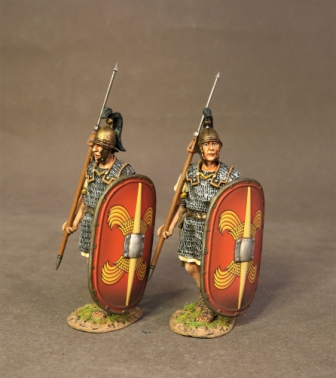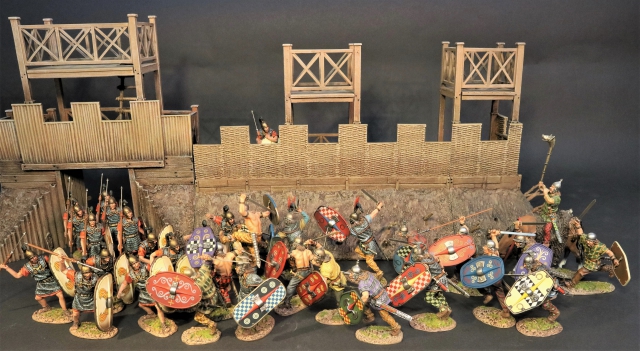 >
>
THE ANCIENTS COLLECTION
ARMIES AND ENEMIES OF ANCIENT ROME
RR-05R
The Roman Army of The Late Republic,
2 Legionaires Marching (Left Leg Forward)
(2pcs)
US$89
The Roman army of the late Republic refers to the armed forces deployed by the late Roman Republic,
from the beginning of the first century B.C.
until the establishment of the Imperial Roman army by Augustus in 30 B.C.
Shaped by major social, political, and economic change,
the late Republic saw the transition from the Roman army of the mid-Republic,
which was a temporary levy based solely on the conscription of Roman citizens,
to the Imperial Roman army of the Principate,
which was a standing,
professional army based on the recruitment of volunteers
REPUBLICAN ROMANS
Roman government was headed by two consuls,
elected annually by the citizens and advised by a senate composed of appointed magistrates.
As Roman society was very hierarchical by modern standards,
the evolution of the Roman government was heavily influenced by the struggle
between the patricians, Rome's land-holding aristocracy,
who traced their ancestry to the founding of Rome,
and the plebeians, the far more numerous citizen-commoners.
Over time, the laws that gave patricians exclusive rights to
Rome's highest offices were repealed or weakened,
and leading plebeian families became full members of the aristocracy.
The leaders of the Republic developed a strong tradition and morality requiring public service
and patronage in peace and war,
making military and political success inextricably linked.
Many of Rome's legal and legislative structures
(later codified into the Justinian Code, and again into the Napoleonic Code)
can still be observed throughout Europe
and much of the world in modern nation states and international organizations.
During the first two centuries of its existence,
the Roman Republic expanded through a combination of conquest and alliance,
from central Italy to the entire Italian peninsula.
By the following century, it included North Africa,
most of the Iberian Peninsula, and what is now southern France.
Two centuries after that, towards the end of the 1st century BC,
it included the rest of modern France, Greece, and much of the eastern Mediterranean.
By this time, internal tensions led to a series of civil wars,
culminating with the assassination of Julius Caesar,
which led to the transition from republic to empire.
Historians have variously proposed Julius Caesar's crossing of the Rubicon River in 49 BC,
Caesar's appointment as dictator for life in 44 BC,
and the defeat of Mark Antony and Cleopatra at the Battle of Actium in 31 BC.
However, most use the same date as did the ancient Romans themselves,
the Roman Senate's grant of extraordinary powers to Octavian
and his adopting the title Augustus in 27 BC,
as the defining event ending the Republic.
We now accept PAYPAL,
to purchase your figures please send your order by e-mail to
inquiry@johnjenkinsdesigns.com
after checking that everything is available,
you will be billed via PAYPAL.
your order will be shipped on confirmation of payment.
worldwide airmail 12%
(minimum postage us$10)
JOHN JENKINS DESIGNS
UNIT 6E, TOWER 2,
KING LEY INDUSTRIAL BUILDING,
33-35 YIP KAN STREET,
WONG CHUK HANG,
HONG KONG
Tel: 852 9041 9065
| |
 >
>

